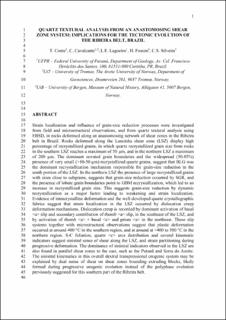| dc.contributor.author | Conte, Thailli | |
| dc.contributor.author | Cavalcante, Carolina | |
| dc.contributor.author | Lagoeiro, Leonardo Evangelista | |
| dc.contributor.author | Fossen, Haakon | |
| dc.contributor.author | Silveira, C.S. | |
| dc.date.accessioned | 2021-04-23T10:56:54Z | |
| dc.date.available | 2021-04-23T10:56:54Z | |
| dc.date.created | 2020-08-08T19:11:01Z | |
| dc.date.issued | 2020 | |
| dc.Published | Journal of South American Earth Sciences. 2020, 103 1-17. | |
| dc.identifier.issn | 0895-9811 | |
| dc.identifier.uri | https://hdl.handle.net/11250/2739331 | |
| dc.description.abstract | Strain localization and influence of grain-size reduction processes were investigated from field and microstructural observations, and from quartz textural analysis using EBSD, in rocks deformed along an anastomosing network of shear zones in the Ribeira belt in Brazil. Rocks deformed along the Lancinha shear zone (LSZ) display high percentage of recrystallized grains, in which quartz recrystallized grain size from rocks in the southern LSZ reaches a maximum of 50 μm, and in the northern LSZ a maximum of 200 μm. The dominant serrated grain boundaries and the widespread (50–85%) presence of very small (>10–50 μm) recrystallized quartz grains, suggest that BLG was the dominant recrystallization mechanism responsible for grain-size reduction in the south portion of the LSZ. In the northern LSZ the presence of large recrystallized grains with sizes close to subgrains, suggests that grain-size reduction occurred by SGR, and the presence of lobate grain boundaries point to GBM recrystallization, which led to an increase in recrystallized grain size. This suggests grain-size reduction by dynamic recrystallization as a major factor leading to weakening and strain localization. Evidence of intracrystalline deformation and the well-developed quartz crystallographic fabrics suggest that strain localization in the LSZ occurred by dislocation creep deformation mechanisms. Dislocation creep is recorded by dominant activation of basal <a> slip and secondary contribution of rhomb <a> slip, in the southeast of the LSZ, and by activation of rhomb <a> + basal <a> and prism <a> in the northeast. These slip systems together with microstructural observations suggest that plastic deformation occurred at around 400 °C in the southern region, and at around at >400–500 °C in the northern region. S–C foliation, quartz <c> axis distribution and several kinematic indicators suggest sinistral sense of shear along the LSZ, and strain partitioning during progressive deformation. The dominance of sinistral indicators observed in the LSZ are also found in parallel shear zones to the east, such as the Putunã and Serra do Azeite. The sinistral kinematics in this overall dextral transpressional orogenic system may be explained by dual sense of shear on shear zones bounding extruding blocks, likely formed during progressive orogenic evolution instead of the polyphase evolution previously suggested for this southern part of the Ribeira belt. | en_US |
| dc.language.iso | eng | en_US |
| dc.publisher | Elsevier | en_US |
| dc.rights | Attribution-NonCommercial-NoDerivatives 4.0 Internasjonal | * |
| dc.rights.uri | http://creativecommons.org/licenses/by-nc-nd/4.0/deed.no | * |
| dc.title | Quartz textural analysis from an anastomosing shear zone system: Implications for the tectonic evolution of the Ribeira belt, Brazil | en_US |
| dc.type | Journal article | en_US |
| dc.type | Peer reviewed | en_US |
| dc.description.version | acceptedVersion | en_US |
| dc.rights.holder | Copyright 2020 Elsevier. | en_US |
| dc.source.articlenumber | 102750 | en_US |
| cristin.ispublished | true | |
| cristin.fulltext | postprint | |
| cristin.qualitycode | 1 | |
| dc.identifier.doi | 10.1016/j.jsames.2020.102750 | |
| dc.identifier.cristin | 1822253 | |
| dc.source.journal | Journal of South American Earth Sciences | en_US |
| dc.source.40 | 103 | |
| dc.relation.project | Andre: 434202/2018-5 to CC, 305232/2018-5, 425412/2018-0 | en_US |
| dc.identifier.citation | Journal of South American Earth Sciences. 2020, 103, 102750. | en_US |
| dc.source.volume | 103 | en_US |

